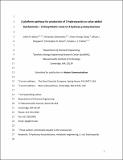A platform pathway for production of 3-hydroxyacids provides a biosynthetic route to 3-hydroxy-γ-butyrolactone
Author(s)
Martin, Collin H.; Dhamankar, Himanshu Hemant; Tseng, Hsien-Chung; Sheppard, Micah James; Reisch, Christopher R.; Prather, Kristala L. Jones; ... Show more Show less
Download12852_1_merged_1354127798.pdf (1.159Mb)
PUBLISHER_POLICY
Publisher Policy
Article is made available in accordance with the publisher's policy and may be subject to US copyright law. Please refer to the publisher's site for terms of use.
Terms of use
Metadata
Show full item recordAbstract
The replacement of petroleum feedstocks with biomass to produce platform chemicals requires the development of appropriate conversion technologies. 3-Hydroxy-γ-butyrolactone has been identified as one such chemical; however, there are no naturally occurring biosynthetic pathways for this molecule or its hydrolyzed form, 3,4-dihydroxybutyric acid. Here we design a novel pathway to produce various chiral 3-hydroxyacids, including 3,4-dihydroxybutyric acid, consisting of enzymes that condense two acyl-CoAs, stereospecifically reduce the resulting β-ketone and hydrolyze the CoA thioester to release the free acid. Acetyl-CoA serves as one substrate for the condensation reaction, whereas the second is produced intracellularly by a pathway enzyme that converts exogenously supplied organic acids. Feeding of butyrate, isobutyrate and glycolate results in the production of 3-hydroxyhexanoate, 3-hydroxy-4-methylvalerate and 3,4-dihydroxybutyric acid+3-hydroxy-γ-butyrolactone, respectively, molecules with potential uses in applications from materials to medicines. We also unexpectedly observe the condensation reaction resulting in the production of the 2,3-dihydroxybutyric acid isomer, a potential value-added monomer.
Date issued
2013-01Department
Massachusetts Institute of Technology. Department of Chemical Engineering; Massachusetts Institute of Technology. Synthetic Biology CenterJournal
Nature Communications
Publisher
Nature Publishing Group
Citation
Martin, Collin H., Himanshu Dhamankar, Hsien-Chung Tseng, et al. 2013 A Platform Pathway for Production of 3-hydroxyacids Provides a Biosynthetic Route to 3-hydroxy-γ-butyrolactone. Nature Communications 4: 1414. 1-10.
Version: Author's final manuscript
ISSN
2041-1723